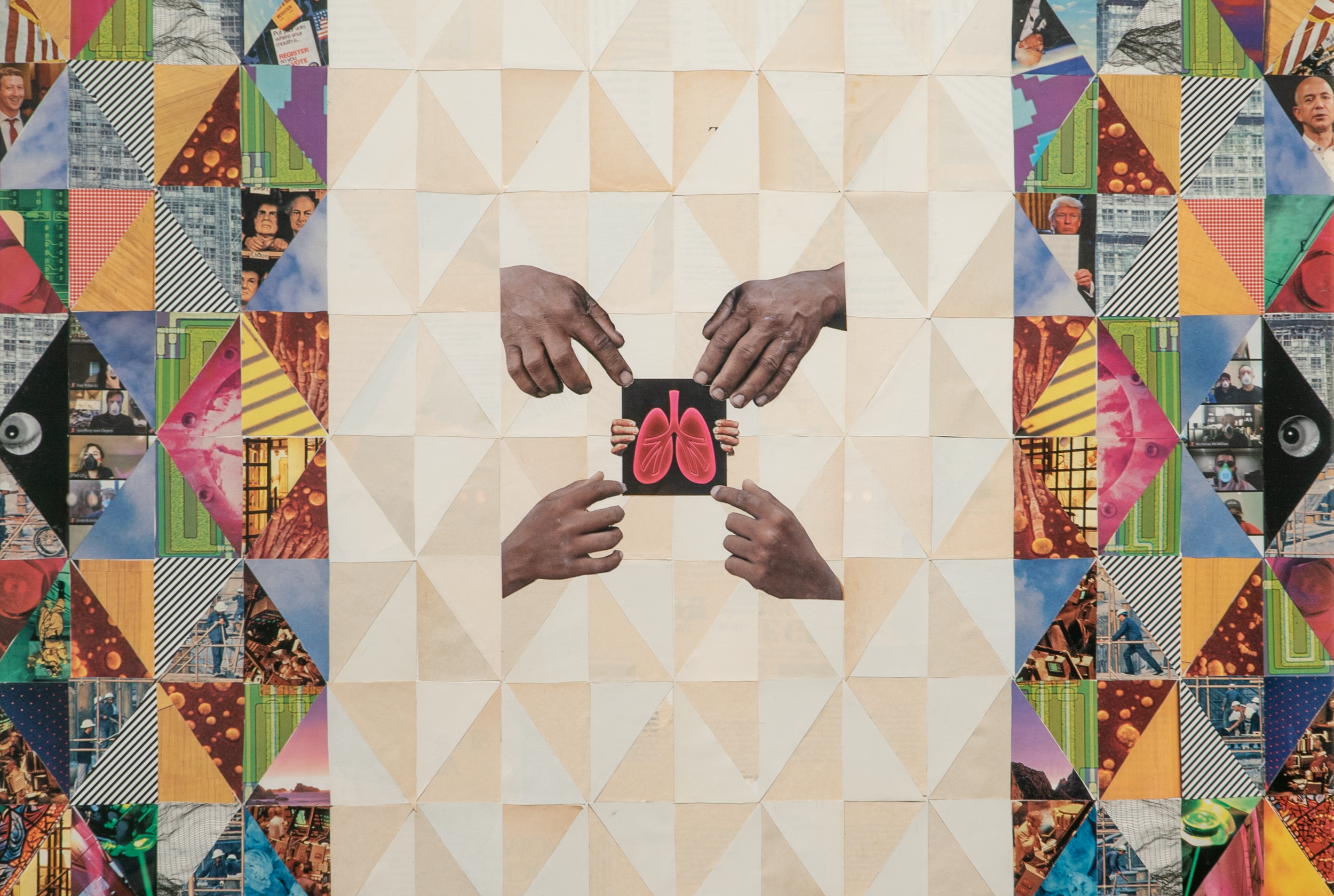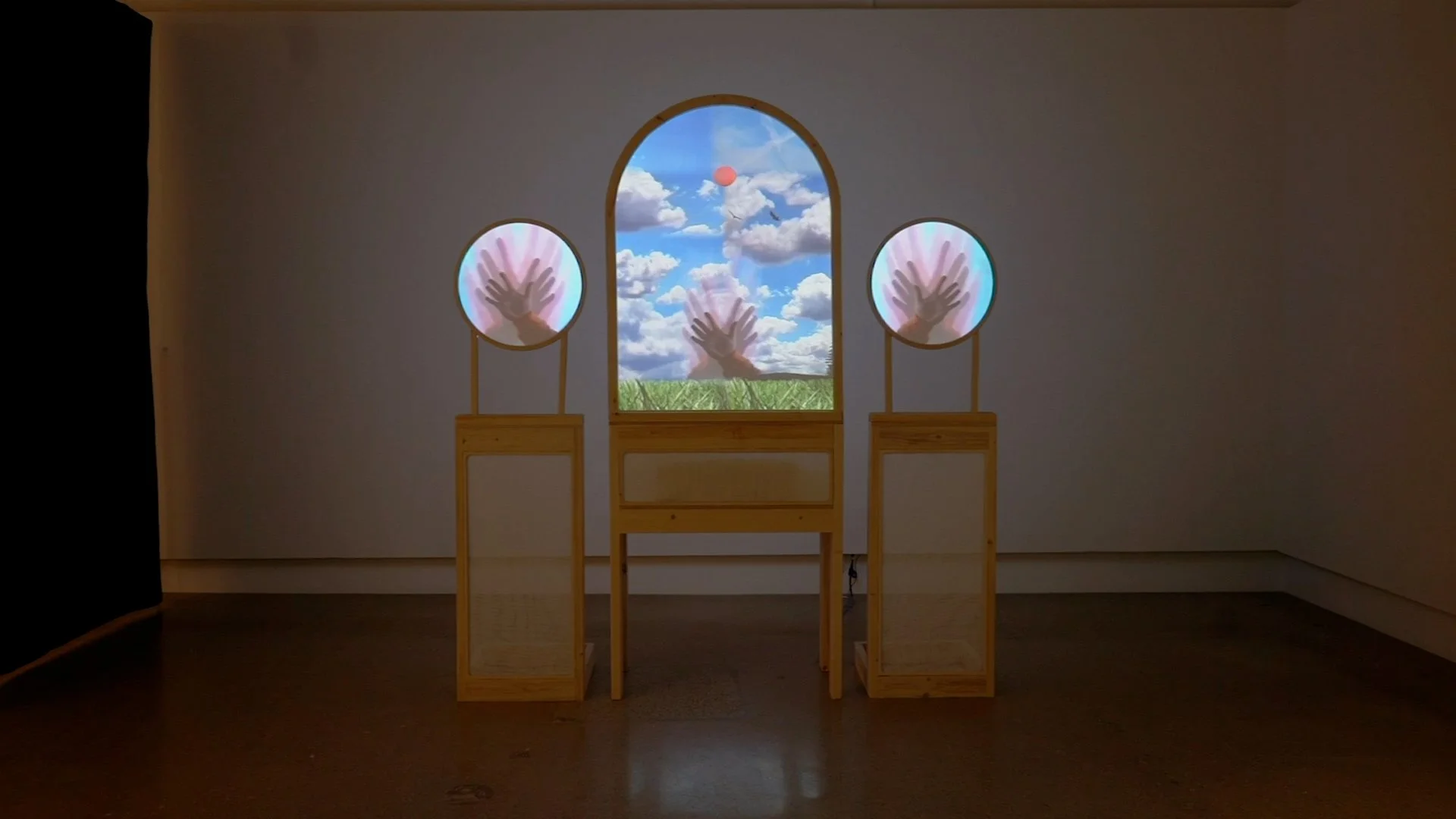
The Latin roots of the word “perspective” break down to the root per-, meaning “through”, and -specere “to look”. Much of the canon of Western art has been dedicated to the cause of creating a window through which the audience is meant to perceive the world. In this process, the medium becomes a means to escape its own materiality. There is a similar process happening with contemporary technology. As digital interfaces gradually become less and less tactile and the quality of everyday screens becomes increasingly crisp, the boundary between technology and our bodies begins to blur. This exhibition is a rejection of both of these things.
Pieces in this exhibition, like open sky and As Above, So Below, compositionally nod to the Western art historical canon and attempt to emulate digital screens while disrupting the audience’s ability to “look through” with fragmented imagery and acknowledgment of materiality. Conversely, stereoscopic pieces like Interior Lens, and The Interior Castle allow the audience to “look through” the interior layers of the contemporary American experience while rejecting the supposed immersion of virtual reality.
Video Documentation

open sky
Projection, wood, vellum, mesh, mirror
83 x 82 x 65”
6:01 min
This video piece was created by collaging dozens of clips shot on a Sony Handycam Hi8 Camcorder. The clips featured on the two side panels were shot by creating a feedback loop between this camera, a projector, a mirror and a backlit vellum screen similar to those featured in this installation. The piece reflects on the spiritual relationship between labor and nature and the self-destructive qualities of the Anthropocene. The video acts as both a creation story and an apocalyptic prophecy, while the loop references the resilient and regenerative potential of the earth and humanity.

Interior Lens, No. 1-3
Wood, LEDs, stereograph viewer, acrylic, polycarbonate, collage
5 x 8 x 8 in
This series of stereograph viewers was created as a contemporary analog middle-ground between traditional stereograph slide viewers like Viewmasters and modern Virtual Reality technology. Like with the Viewmaster, the stereograph slides are transparent and interchangeable, but they are electrically backlit and the use of a repurposed VR Viewer allows the image to fill more visual space than a Viewmaster. While the design of the viewers is meant to keep technology at an arm’s length, the collages reflect on the ways in which technology already occupies so much of the interior life of contemporary humans.
the collages
This series of digital collages were created by first creating each composition in Photoshop, and then separating each layer in a 3D model in After Effects. Once that model is created, a virtual camera can be moved around it to create multiple vantage points of the layers. This camera movement is represented in the parallax animations below.
see the full Interior Lens page for more details…

As Above, So Below
Digital collage, animation
This collage was created by scanning hundreds of images from magazines and arranging them in Photoshop. Each individual section was then animated in After Effects. The piece is compositionally based on a 13th-century icon of St. Francis titled St. Francis and Scenes from His Life. The collage borrows from the icon’s vertical storytelling and inverts the symbols and values associated with St. Francis (poverty, love of nature, peace) in order to depict modern capitalism as a mythical beast. Conceptually, the piece is influenced by Eugene McCarraher’s book The Enchantments of Mammon: How Capitalism Became the Religion of Modernity.
see the full As Above, So Below page for more details…

The Interior Castle
Lenticular print, hand-cut collage
The original hand-cut version of this collage incorporated three laser holograms which were featured on the covers of National Geographic in the 1980s. The process of trying to document the original collage led to a number of experiments with video, animation, and 3D viewing systems. Eventually, these experiments led to reformatting the entire collage into separate layers and having it printed as a 3D lenticular. Conceptually, the collage is heavily based on the themes of Naomi Klein’s 2007 book The Shock Doctrine: The Rise of Disaster Capitalism, specifically the relationship between death, capitalism and propaganda.
see the full The Interior Castle page for more details…

A Quilt for Your Lungs
Hand-cut collage
This hand-cut collage was made by creating a quilt pattern that designated the locations of eight colors throughout a geometric lattice drawn onto the paper. The individual magazine clippings were then cut and glued according to their color. The piece is an attempt to create order from the political chaos and information overload of 2020.
see the full A Quilt for Your Lungs page for more details…
Wall text & promotional materials
















